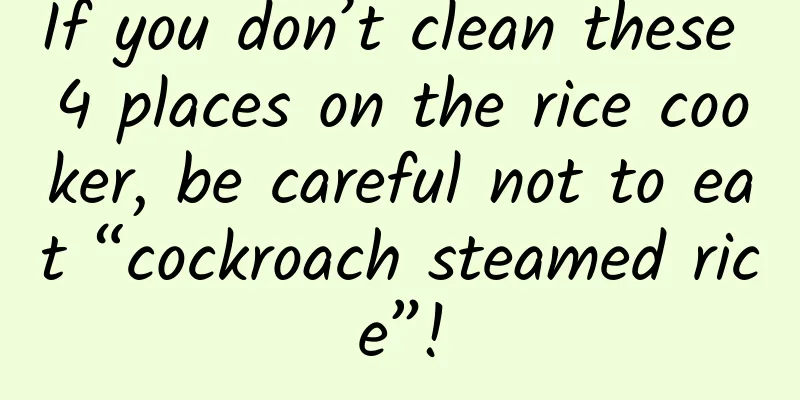If you don’t clean these 4 places on the rice cooker, be careful not to eat “cockroach steamed rice”!

|
When I was surfing the Internet some time ago, I found a post that made me split - a netizen found a cockroach at the bottom of a rice cooker that had not been cleaned for a long time: Image source: Xiaohongshu Who knows? I used to only wash the inner pot of the rice cooker, thinking it would be clean enough... How to clean a rice cooker? Let's talk about it today~ The 4 positions of the rice cooker Be sure to clean it in time! Many people think that rice cookers do not need to be cleaned, or that they only need to clean the inner pot. However, in fact, the structure of rice cookers is complex, and there are many places where dirt and grime can be hidden. If they are not cleaned for a long time, bacteria and mold will grow. In addition, the steam cooking method of rice cookers means that dirt stuck to other places will also contaminate the food along with the water droplets produced by the steam after the pot is opened. So, in addition to the inner pot of the rice cooker, there are also these parts that need to be washed - the air jet, the detachable top cover and sealing rubber ring, the anti-overflow box, the bottom heating element (electric heating plate), etc. Schematic diagram of an early mechanical rice cooker. Image from the Internet 1 Jet Rice soup often overflows from the jet of the rice cooker. If the rice soup in the jet is not cleaned in time, it will produce Salmonella, Escherichia coli, Staphylococcus aureus and aflatoxin, a first-class carcinogen, etc. These bacteria will flow back into the pot when the rice cooker is used next time, contaminating food and endangering health. Many people like to use electric rice cookers to stew meat and cook. The soup and oil stains overflowing from the jet will create a more complex bacterial environment. The oil stains may also clog the jet . If it is a high-pressure rice cooker, this situation may even cause an explosion. Cleaning recommendations: Many brands of rice cookers now have a detachable steam hole cap for easy cleaning. This detachable structure allows all removable parts (such as the hole cap and steam hole rubber ring) to be removed during washing, and then they can be cleaned and dried. It should be noted that the steam hole rubber ring is generally delicate in structure and soft in texture, so be careful not to damage it when disassembling. 2 Sealing rubber ring The sealing ring is also a hygiene blind spot that is often overlooked. The rice soup and vegetable soup retained in the sealing ring will also produce a large number of bacteria and mold. Many people will find a layer of black sticky substance hidden inside the rice cooker sealing ring after opening it. These pollutants will flow into the pot with the distilled water flowing down the rubber ring when you open the lid next time, thereby contaminating the food. Cleaning recommendations: Most brands of rice cookers now have the sealing rubber ring installed on the detachable top cover. Just remove it and turn over both sides of the rubber ring to clean it. If it is the kind that cannot be removed, wipe it with a cotton swab dipped in baking soda and white vinegar to remove stubborn dirt. 3 Anti-overflow box Some rice cookers are equipped with a water storage box to prevent overflow. The box is located in a very hidden place and will get moldy if not cleaned. Sometimes insects such as cockroaches will drill into the structure through the water storage box, which is very scary. Cleaning recommendations: Don't wait until the overflow box is full before pouring it out!!! 4 Hot Plate When serving rice, food residues, dripping water and rice soup accidentally fall around the heating element under the inner pot. Over time, the heating plate will turn yellow and black and form thick dirt, which will damage the performance of the rice cooker. Uncooked rice is a small matter, but causing a short circuit is a big problem. Cleaning recommendations: Dip a small brush in baking soda or professional cleaning agent, and clean along the grain of the hot plate . After cleaning, wipe it clean with a semi-dry soft cloth. It should be noted that when cleaning the hot plate, be sure to turn off the power and do not immerse it in water, otherwise it may cause a short circuit and you may even get an electric shock. In addition to these, friends in the south may need to shake the rice cooker frequently and observe whether there is any unusual movement inside the shell. If you feel something or impurities fall from the heat dissipation port, you may need to take it apart and have a look... I won't tell you the reason, you know. Be careful when using a rice cooker Although rice cookers are convenient to use, they can still be dangerous if used improperly. In addition to not immersing the heating element in water and turning off the power when cleaning it, there are actually many other things to note when using and cleaning a rice cooker. 1 Wash and dry, then cover Because the rice cooker itself has the function of keeping warm and moisturizing, when cleaning the rice cooker, all detachable parts, including the detachable top cover and inner pot, must be dried or wiped with a clean soft cloth before installation after cleaning. After using and cleaning the rice cooker, it is best to open the lid first, let it dry in a clean and ventilated place for a while before covering it with the lid, otherwise the humid internal environment may still breed bacteria and mold. 2 Unplug the power supply while turning off the heat preservation The keep-warm function of the rice cooker is very useful, but remember to unplug the power cord after use, and never leave the keep-warm function on. The rice in the pot turning sour is a minor matter, but the potential fire hazard is a major problem. 3 If the inner liner coating is damaged, replace it in time The inner pot of the old-fashioned rice cooker is generally made of aluminum alloy or stainless steel. In recent years, refined iron, ceramic and composite materials have become more common. There are relatively more materials for the inner pot coating, and common coating materials include Teflon, ceramic crystal, PEEK, etc., each with its own advantages and disadvantages. But no matter which type of liner you use, try not to use hard materials such as steel wool to scrub it, otherwise it will easily damage the coating, causing harmful substances to leak out , and coating particles to mix into food, which will affect health. If the coating of the liner is found to be damaged, it must be replaced in time. 4 Don't buy low-quality rice cookers When an electric rice cooker is in use, the power and heat generated are relatively large. If you encounter products that use low-quality wires or heating plates, it is easy to cause a short circuit or even a fire, which is very dangerous. In addition to circuit components, the factors that affect the quality of rice cookers include the materials of the inner pot and the top cover. Some unscrupulous manufacturers use inferior products as good ones and choose materials that do not meet the regulations for production, which is prone to strong odor when boiling and pungent odor when used, which is not good for health. In any case, choosing well-known brands and products with a good reputation can better guarantee product safety and after-sales service. 5 Do not block the air outlet of the high pressure rice cooker Remember, a high-pressure rice cooker is also a pressure cooker. If the jet is blocked, it will explode within a few minutes, which is very dangerous. Therefore, do not cover it with a towel to prevent food and soup from splashing, and do not put anything on the top cover during use. Before using this rice cooker, read the instructions carefully. Finally, let’s summarize: The rice cooker must be washed, and washed well. After washing, it must be dried before covering the lid. Always check the wear of the inner pot and the top cover to prevent foreign objects from entering. Most importantly, as a household appliance, the rice cooker must be used and cleaned with attention to safe electricity use. Remember this. Now, go check your rice cooker. (One more thing to add: even if there are cockroaches, don’t be afraid. Although you may feel disgusted, you can actually eat them. There is no safety issue. Insect protein is the future development direction.) Planning and production Author: Likely Popular Science Creator Reviewer: Ruan Guangfeng, Director of Science and Technology Department, Kexin Food and Nutrition Information Exchange Center Planning丨Yang Yaping Editor: Yang Yaping Proofread by Xu Lailinlin |
<<: In order to build a solid power supply barrier, he "races" against disasters!
>>: Explore the Earth's Treasures! World Geoparks, Have You Got It?
Recommend
Why are fish still alive when they are placed in a sealed plastic bag?
Your browser does not support the video tag When ...
Event Operation: To clarify “brand exposure event”, start by understanding these 5 points!
"Brand exposure activities" are activit...
What are the three major cosmic velocities? Why is the fourth cosmic velocity rarely mentioned?
We all know that nearly 400 years ago, physicist ...
Sina Fans Promotion Strategy, a must-learn for App operation and promotion personnel!
Someone told me that Sina Weibo’s scale is not up...
Business rules for operating e-commerce platforms!
In the future, life will become more and more dif...
Community Operation丨The essence and gameplay of "private domain traffic" in 2019!
Last year, every time I attended a marketing indu...
How to place KOLs on Weibo and WeChat to achieve the maximum effect?
Kol, Key Opinion Leader, is basically those peopl...
Is it a good thing that private domain traffic is concentrated on WeChat marketing?
Ever since the concept of " private domain t...
Harvest in China | Satellite view of autumn harvest: good harvest everywhere
Harvest in China | Satellite view of autumn harve...
Apple iOS 11 may no longer support 32-bit, and a large number of old apps may be invalidated
Apple's software store already has millions o...
Selling in large quantities at small profits is a foolish approach. Check out the 12 most profitable marketing rules of the Jews!
There is a reason why Jews are known as the smart...
A different way to promote APP: Analysis of the operation strategy of "Youlin"!
The author of this article is Tian Zuo, who has b...
What is the difference between opening a Baidu framework account and a Baidu port account?
What are the Baidu account opening channels, Baid...
What did Baidu do with its 7 billion research funds?
[[128328]] It is said that this is Baidu's in...
How to attract traffic on Weibo? Precise traffic generation techniques on Weibo!
In this era, many people are scrambling to gather...









